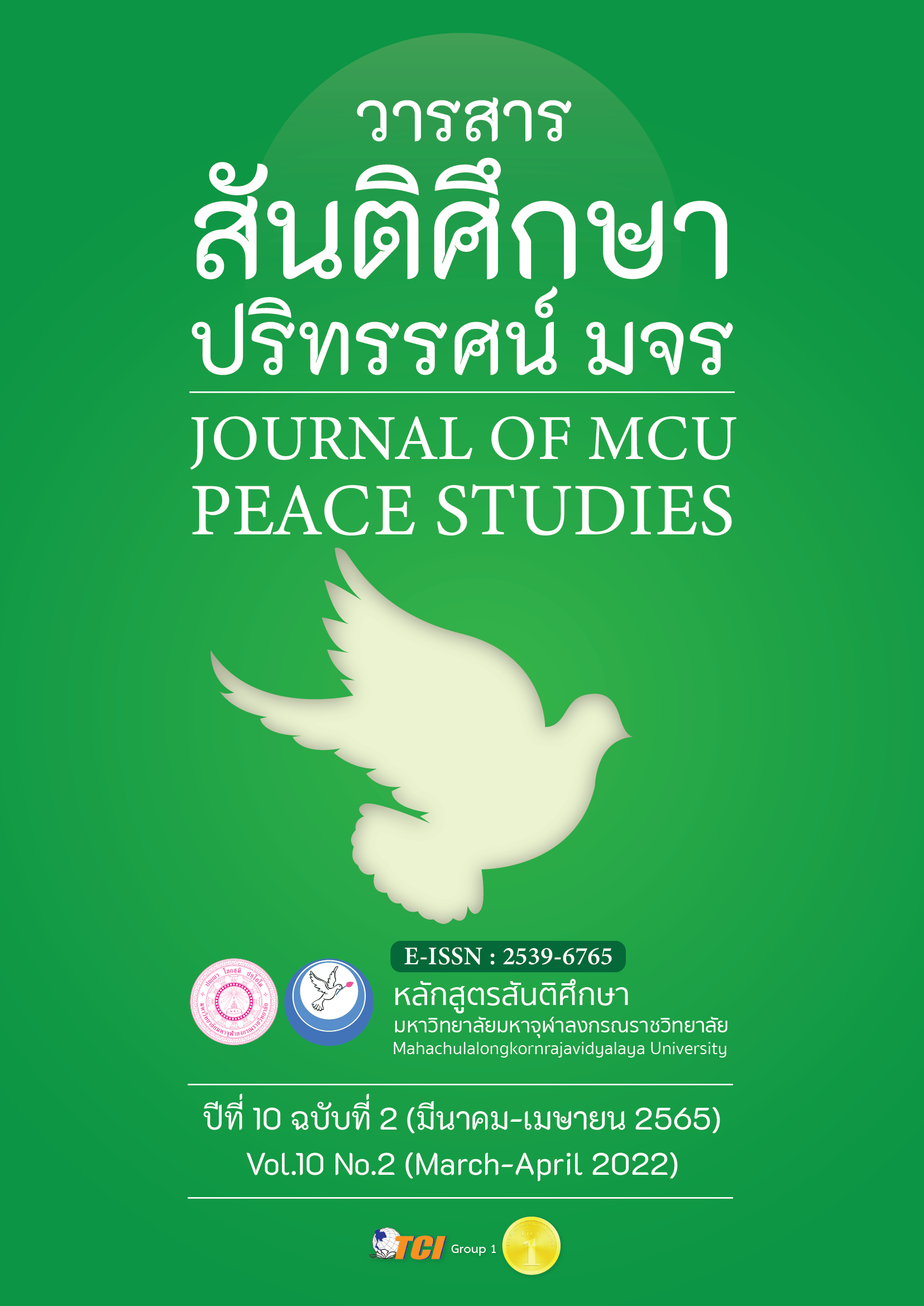การวิเคราะห์องค์ประกอบเชิงสำรวจ และการประเมินประสิทธิภาพการจัดการชายหาด กรณีศึกษาหาดป่าตอง จังหวัดภูเก็ต
Main Article Content
บทคัดย่อ
บทความวิจัยมีวัตถุประสงค์เพื่อ 1) วิเคราะห์องค์ประกอบเชิงสำรวจของการจัดการชายหาดป่าตอง และ 2) เพื่อประเมินประสิทธิภาพการจัดการชายหาดป่าตอง การวิจัยใช้รูปแบบการวิจัยแบบผสานวิธี คือ
การวิจัยเชิงคุณภาพ มีผู้ให้ข้อมูลสำคัญได้แก่ นักท่องเที่ยวทั้งชาวไทยและชาวต่างประเทศ จำนวน 30 คน คัดเลือกผู้ให้ข้อมูลสำคัญโดยการเลือกแบบเจาะจง คือเจาะจงเป็นนักท่องเที่ยวที่เดินทางมาท่องเที่ยวยังชายหาดป่าตองขณะทำการเก็บข้อมูล เครื่องมือการวิจัยคือแบบสัมภาษณ์ วิเคราะห์ข้อมูลเชิงคุณภาพโดยการวิเคราะห์เชิงเนื้อหา สำหรับการวิจัยเชิงปริมาณ กลุ่มตัวอย่างแบ่งเป็นนักท่องเที่ยวชาวไทย 200 คนและนักท่องเที่ยวชาวต่างชาติ 200 คน โดยคัดเลือกกลุ่มตัวอย่างแบบโควต้า เครื่องมือการวิจัยคือแบบสอบถาม วิเคราะห์ข้อมูลโดยใช้สถิติเชิงพรรณนา และการวิเคราะห์องค์ประกอบเชิงสำรวจด้วยวิธีการสกัดองค์ประกอบหลักด้วยวิธี Principal Components Analysis และเลือกวิธีการหมุนแกน Varimax
ผลการวิจัยพบว่า 1) การวิเคราะห์องค์ประกอบเชิงสำรวจของการจัดการชายหาดป่าตองสามารถจัดองค์ประกอบประสิทธิภาพการจัดการชายหาดได้ 6 องค์ประกอบจากทั้งหมด 39 ตัวแปร ได้แก่ ด้านกายภาพชายหาด ด้านการแบ่งเขต ด้านผู้ประกอบการ ด้านความปลอดภัยและสิ่งสนับสนุนการท่องเที่ยว ด้านสิ่งแวดล้อม และด้านสุขอนามัย 2) ผลการประเมินประสิทธิภาพการจัดการในแต่ละองค์ประกอบพบว่า ประสิทธิภาพการจัดการชายหาดสูงสุด ได้แก่ ความกว้างของชายหาด ความเหมาะสมของการให้บริการของสถานบันเทิง ปริมาณร้านอาหาร ความเหมาะสมของการให้บริการกิจกรรมทางน้ำ ความใสของน้ำทะเล ความเพียงพอและความพร้อมใช้งานของห้องอาบน้ำและห้องน้ำสาธารณะ ด้านที่มีประสิทธิภาพการจัดการต่ำที่สุด ได้แก่ ความสะอาด ความปลอดภัยของถนน ความเหมาะสมของราคา จำนวนที่จอดรถสาธารณะ การจราจร และ ความสะอาดของห้องอาบน้ำสาธารณะ โดยผลการศึกษาสามารถนำไปประยุกต์ใช้เพื่อวางแผนการจัดการการท่องเที่ยวได้ในอนาคต
Article Details

อนุญาตภายใต้เงื่อนไข Creative Commons Attribution-NonCommercial-NoDerivatives 4.0 International License.
ทัศนะและความคิดเห็นที่ปรากฏในบทความในวารสาร ถือเป็นความรับผิดชอบของผู้เขียนบทความนั้น และไม่ถือเป็นทัศนะและความรับผิดชอบของกองบรรณาธิการ ยินยอมว่าบทความเป็นลิขสิทธิ์ของวารสาร
เอกสารอ้างอิง
2. Botero, C., Pereira, C., Tosic, M., & Manjarrez, G. (2015). Design of an index for monitoring the environmental quality of tourist beaches from a holistic approach. Ocean Coastal Management, 108, 65-73.
3. Cagilaba, V., & Rennie, H. (2005). Literature review of beach awards and rating systems (Report No. 2005/24). Hamilton: Environmental Waikato.
4. Cervantes, O., & Espejel, I. (2008). Design of an integrated evaluation index for recreational beaches. Ocean Coastal Management, 51(5), 410-419.
5. Department of Tourism. (2018). Manual of Standard Assessment for Beach Destination. Bangkok: Office of Printing Affairs, the War Veterans Organization of Thailand In the royal palace.
6. Ergin, A., Williams, A., & Micallef, A. (2006). Coastal scenery: appreciation and evaluation. Journal of Coastal Research, 22(4 (224)), 958-964.
7. Guba, E.G. & Lincoln, Y.S. (1989). Fourth Generation Evaluation. Newbury Park, CA: Sage.
8. James, R. (2000). From beaches to beach environments: linking the ecology, human-use and management of beaches in Australia. Ocean Coastal Management, 43(6), 495-514.
9. Jeenbubpha, N. (2009). Physical Environment Assessment Model for Tourism Beach. (Master’s Thesis), Silapakorn University. Nakhonpathom.
10. Khattabi, A., Williams, A.T. & Ergin, A., 2009. Assessment of quality and attraction of the sandy beaches of Nador province – Morocco, (In), Bayed A. (Ed.) Sandy beaches and coastal zone management – Proc. the Fifth International Symposium on Sandy Beaches, Rabat, Morocco. Travaux de l'Institut Scientifique, Rabat, Série générale, 6, 59-64.
11. Leatherman, S. P. (1997). Beach rating: a methodological approach. Journal of coastal research, 13, 253-258.
12. Micallef, A., Williams, A., & Gallego Fernandez, J. B. (2011). Bathing area quality and landscape evaluation on the Mediterranean coast of Andalucia, Spain. Journal of Coastal Research, (61), 87-95.
13. Micallef, A. S., Williams, A. T., Radic, M., & Ergin, A. (2004). Application of a novel bathing area evaluation technique—a case study of Croatian island beaches. World Leisure Journal, 46(4), 4-21.
14. Phillips, M. R., & House, C. (2009). An evaluation of priorities for beach tourism: Case studies from South Wales, UK. Tourism Management, 30(2), 176-183.
15. Phuket Province Statistical Office. (2019). Tourist and Sport Statistics in 2019, Phuket Province. Retrieved 5 May, 2020, from http://phuket.nso.go.th/index.php?option=com_content&view=article&id=373&Itemid=646
16. Schuhmann, P. 2011. “Tourist Perceptions of Beach Cleanlinessin Barbados: Implications for Return Visitation.” Études caribéennes 19. Doi: 10.4000/etudescaribeennes.5251.
17. Angsuchoti, S., Wijitwanna, S., & Pinyopanuwat. R. (2008). Statistical analysis for social science and behavioral research Techniques for using LISREL program. Bangkok: Mission Media.
18. The Office of National Economic and Social Development Board. (2011). Report of studies on the the Southern coastal areas development. Retrieved 30 September, 2018, from https://www.nesdc.go.th/ewt_w3c/ewt_dl_link.php?nid=2647
19. Turner, R. C., & Carlson, L. (2003). Indexes of item-objective congruence for multidimensional items. International Journal of Testing, 3(2), 163-171.
20. United Nations Environment Programme. Division of Technology, & Economics. (2005). Making tourism more sustainable: A guide for policy makers. Retrieved 5 May, 2020, from https://wedocs.unep.org/handle/20.500.11822/8741
21. Van Maele, B.K., Pond, K., Williams, A.T. and Dubsky, K. 2000. Public participation and communication. In Monitoring Bathing Waters: A Practical Guide to the Design and Implementation of Assessments and Monitoring Programmes. London and New York: World Health Organisation
22. Yamane, T. (1973). Statistics: An Introductory Analysis. 3rdEd. New York: Harper and Row Publications.
23. Vanichbuncha, K. (2014). Statistics and quantitative analysis. Bangkok: Chulalongkorn University.
24. Zielinski, S., Botero, C. M., & Yanes, A. J. M. p. b. (2019). To clean or not to clean? A critical review of beach cleaning methods and impacts. Marine Pollution Bulletin, 139, 390-401.


